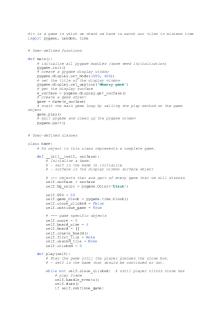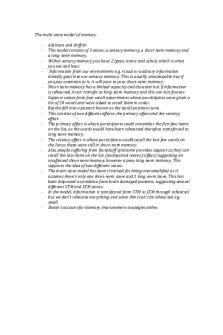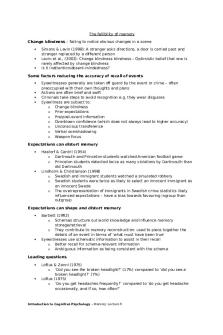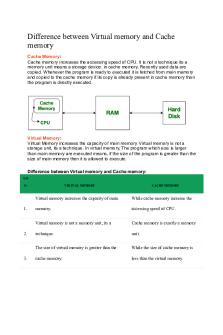Memory - The fallibility of memory PDF

| Title | Memory - The fallibility of memory |
|---|---|
| Course | Cognition |
| Institution | University of Lincoln |
| Pages | 6 |
| File Size | 179.6 KB |
| File Type | |
| Total Downloads | 42 |
| Total Views | 154 |
Summary
The fallibility of memory - how things can go wrong...
Description
The fallibility of memory Change blindness – failing to notice obvious changes in a scene
Simons & Levin (1998): A stranger asks directions, a door is carried past and stranger replaced by a different person Levin et al., (2002): Change blindness blindness – Optimistic belief that one is rarely affected by change blindness Is it inattention/absent-mindedness?
Some factors reducing the accuracy of recall of events
Eyewitnesses generally are taken off guard by the event or crime – often preoccupied with their own thoughts and plans Actions are often brief and swift Criminals take steps to avoid recognition e.g. they wear disguises Eyewitness are subject to: o Change blindness o Prior expectations o Pre/post-event information o Overblown confidence (which does not always lead to higher accuracy) o Unconscious transference o Verbal overshadowing o Weapon focus
Expectations can distort memory
Hastorf & Cantril (1954) o Dartmouth and Princeton students watched American football game o Princeton students detected twice as many violations by Dartmouth than did Dartmouth Lindholm & Christianson (1998) o Swedish and immigrant students watched a simulated robbery o Swedish students were twice as likely to select an innocent immigrant as an innocent Swede o The overrepresentation of immigrants in Swedish crime statistics likely influenced expectations – have a bias towards favouring ingroup than outgroup
Expectations can shape and distort memory
Bartlett (1932) o Schemas structure out world knowledge and influence memory storage/retrieval o They contribute to memory reconstruction: used to piece together the details of an event in terms of ‘what must have been true’ Eyewitnesses use schematic information to assist in their recall o Better recall for schema-relevant information o Ambiguous information as being consistent with the schema
Leading questions
Loftus & Zanni (1975) o ‘Did you see the broken headlight?’ (17%) compared to ‘did you see a broken headlight?’ (7%) Loftus (1975) o ‘Do you get headaches frequently?’ compared to ‘do you get headache occasionally, and if so, how often?’
Introduction to Cognitive Psychology – Memory: Lecture 3
Loftus & Palmer (1974) o Watched a multiple-car accident and asked how fast the car was going when the cars… (replaced with a variety of words e.g. smashed into/hit/collided with/bumped/contacted’) each other o Estimated speed was around 41 mph for smashed, 39 mph for collided, 38 mph for bumped, 34 mph for hit and 32 mph for contacted Loftus, Miller & Burns (198) o ‘Did another car pass the red Datsun while it was stopped at the … sign?’ o After 20 minutes, there was 75% accuracy in the consistent condition and 40% in the inconsistent condition o After 2 weeks, there was 60% accuracy in the consistent condition and 20% in the inconsistent condition
Interference and memory distortion Retroactive interference
Eakin, Schreiber and Sergent-Marshall (2003) o Eyewitness memory impaired by misleading information presented after crime witnessed o Memory impaired even when eyewitnesses warned about the presence of misleading information Source monitoring framework explains retroactive interference distortion o A memory probe activates related traces including memories from other sources o Sometimes, source misattributions occur o This is especially likely when memories from different sources are similar Oklahoma city bombing in 1995: 1 day after McVeigh rented the van, 2 different men came in and rented a van. Second interviewee had correctly remembered features but misattributed them to the wrong episode - 2 different men were sought in connection with the bombing Overwriting the original memories is another explanation (Loftus, 1979) o People who saw inconsistent information were much less accurate – 7085% selected the sign (stop, yield) that they were falsely led to believe existed (even though paid for correct answers to reduce demand characteristics) o Information from misleading questions permanently alters the original memory, which is overwritten and destroyed
Proactive interference
Lindsay et al., (2004) o Listened to a thematically similar or dissimilar narrative prior to seeing a burglary o Recall errors were more frequent when the prior narrative was similar to the actual event o Eyewitness’ pervious experiences can shape what they remember
Misinformation effect: Caveats
Introduction to Cognitive Psychology – Memory: Lecture 3
Bekerian & Bowers (1983): o Misinformation effects are eliminated by systematically questioning participants from earlier incidents to later ones o Suggests that original memory trace survives Loftus (1992) – emphasised that eyewitness can comes to accept misleading information: o More likely as decay increases o The original memory need not be overwritten – the new (incorrect) information is simply added to the rest Heath & Erickson (1998) – memory distortions are more common for peripheral/minor details
Individual differences – age
Young children and elderly adults are more susceptible to misleading information – elderly adults tend to be very confident in their false memories Older adults are more likely to choose someone from a line-up, even when the culprit is absent Own age bias (Wright & Stroud, 2002): People focus on features of other people like themselves – it is easier to identify from a line-up when it consists of people of the eye witness’ own age Steps to reduce age biases: o Ensure older adults and children are not exposed to misleading information o Ask the elderly detailed questions to help them weed out source misattributions
Eyewitness confidence
Sporer et al., (1995): o Weak correlation between confidence and accurate identification o Confidence predicts general knowledge accuracy o Confidence is not always a good predictor of accuracy Perfect & Hollins (1996) – the difference is due to: o Witnesses are often coached to be more confident o They also receive confirming feedback from investigators Bradfield, Wells & Olson (2002): o Participants identify a man in a video from a 6-person line-up o Confirming feedback increased eyewitness’ confidence more when they were incorrect than when they were correct
Influences of anxiety and violence – weapon-focus effect
Witnesses are less likely to accurately identify a target when a weapon is involved (Loftus, 1979) due to attention being drawn to the weapon at the expense of other aspects of the situation Participants spend more time looking at weapons than a non-weapon substitute (Loftus, Loftus & Messo, 1987) Influence of anxiety and violence is hard to assess in the lab because it is unethical Typical lab experiments involve film or staged crucial incident (either violent/nonviolent) Common findings: o Memory for the central aspects of an incident are enhanced by presence violence e.g. the weapon-focus effect o Memory for the peripheral aspects of an incident are reduced by the presence of violence
Introduction to Cognitive Psychology – Memory: Lecture 3
Pickle (1999) suggests two reasons why a weapon draws more attention: 1) It poses a threat, 2) It is unexpected. He found that expected settings improved the ability to identify but threat did not influence the ability to identify o Unexpected low threat: gun pointed at ground in a baseball field o Unexpected high threat: gun pointed at woman in a baseball field o Expected low threat: gun pointed at ground in a shooting range o Expected high threat: gun pointed at woman in a shooting range Deffenbacher et al.’s (2004) meta-analysis revealed that heightened anxiety and stress: o Negatively impact eyewitness identification accuracy o Reduce the ability of eyewitness to remember: culprit details, crime scene details and actions of central characters
Remembering faces
Prosopagnosia: ‘face blindness’ Bruce et al., (1999): Asked participants to match faces o Only 65% accurate when the correct face was present o 35% of participants still picked a face even when the correct face wasn’t present o A video, in conjunction with the photograph, did not improve recognition o Neurotypical people’s face recognition ability is poorer than we think
Factors influencing face memory – Patterson & Baddeley (1977)
We categorise faces based on: o Physical features: chin, nose, eyes, type of hair o Psychological features: honesty, intelligence, liveliness Participants are better at recognising faces they earlier categorised on psychological dimensions rather than by physical features Adding a disguise (or removing one from the categorised face) reduced recognition performance Faces seen in three quarter view are more recognisable than faces seen in profile
Holistic face processing
Holistic/global processing: processing the overall structure of a face/object and paying little attention to the details Farah (1994): Faces are processed holistically whereas objects are processed in more detail Inverted faces: o It is harder to recognise the overall structure of a face when it is inverted, compared to an object o Any difficulty recognising inverted objects quickly disappears with practise – this is not true for inverted faces o Leads to the Thatcher Illusion (Thompson, 1980)
Misattribution memory and unconscious transference
Introduction to Cognitive Psychology – Memory: Lecture 3
Unconscious transference: the tendency to misidentify a familiar but innocent face as belonging to a culprit Ross et al., (1994): o Eyewitnesses were 3x more likely to select an innocent bystander from a line-up than a stranger o The effect was eliminated by informing them before the line-up that the bystander was not the culprit Valentine, Pickering & Darling (2003) – analysis of 314 real line-ups o 40% identified the suspect o 20% identified a non-suspect o 40% failed to identify anyone
The 7 sins of memory
Sins of omission/forgetting - things are missing from memory in some way o Transience o Absent-mindedness o Blocking Sins of commission (errors) – memory is present but is incorrect or unwanted o Misattribution o Suggestibility o Bias o Persistence
Baker/baker paradox
Learn to associate pictures with a word, later presented pictures and asked to recall the associated word Paired with names ‘Baker’, paired with occupation ‘baker’
Lab vs. real-life settings Lab conditions…
Tend to ask for information from individuals not directly involved in the crime (not the victims themselves) Less stressful and anxiety-provoking Provide the eyewitness with only a single, passive perspective o They cannot move around or interact with other participants in the event Typically grant witnesses far less time to view the event/people Carry only minimal consequences for inaccurate information or false identifications
Improving police interviews – the cognitive interview (Geiselman et al., 1985)
Retrieval rule: mental reinstatement of the context and encouraging complete reporting (even small details) > Empirical basis: encoding specificity principle > Goal: improve the match between encoding and retrieval contexts Retrieval rule: attempting to describe the events in several different orders and reporting the incident from different viewpoints/perspectives > Empirical basis: memory traces are complex and contain various features > Goal: prompting access to multiple, different cues improves recall
Summary
Eyewitnesses are subject to: o Change blindness: failure to detect changes in the environment o Prior expectations
Introduction to Cognitive Psychology – Memory: Lecture 3
Pre/post-event information: proactive/retroactive interference Overblown confidence Unconscious transference due to source misattributions Verbal overshadowing: brief descriptions of a face impair recognition of that face o Weapon focus: attention is so drawn to a weapon that memory for the other details is impaired – it is more apparent in lab settings than in real life Face processing is: o Often inaccurate, especially when the face is disguised o More holistic and less detail-oriented than object processing o Subject to source misattributions – leads to unconscious transference (when eyewitnesses mistakenly identify a familiar face as belonging to a criminal) o Affected by the cross-race effect – occurs mainly because we don’t process the faces of outgroup members as thoroughly as those of ingroup members Police line-up can be improved by: o Warning witnesses that the culprit may not be present in the line-up o Using sequential line-ups rather than simultaneous ones Eyewitnesses remember more if questioned through the cognitive interview method: o Attempts to match encoding and retrieval contexts o Asks witnesses to recall information from a variety of perspective and orders o o o o
Introduction to Cognitive Psychology – Memory: Lecture 3...
Similar Free PDFs

Memory
- 3 Pages

Memory
- 5 Pages

Tulving - chapter: the memory
- 1 Pages

Virtual Memory
- 58 Pages

CACHE MEMORY
- 1 Pages

Memory Psych
- 1 Pages

Virtual Memory
- 17 Pages

Memory notespack
- 16 Pages

Memory Management
- 5 Pages

9.) Memory
- 4 Pages

Nondeclarative Memory
- 3 Pages

The multi store model of memory
- 2 Pages
Popular Institutions
- Tinajero National High School - Annex
- Politeknik Caltex Riau
- Yokohama City University
- SGT University
- University of Al-Qadisiyah
- Divine Word College of Vigan
- Techniek College Rotterdam
- Universidade de Santiago
- Universiti Teknologi MARA Cawangan Johor Kampus Pasir Gudang
- Poltekkes Kemenkes Yogyakarta
- Baguio City National High School
- Colegio san marcos
- preparatoria uno
- Centro de Bachillerato Tecnológico Industrial y de Servicios No. 107
- Dalian Maritime University
- Quang Trung Secondary School
- Colegio Tecnológico en Informática
- Corporación Regional de Educación Superior
- Grupo CEDVA
- Dar Al Uloom University
- Centro de Estudios Preuniversitarios de la Universidad Nacional de Ingeniería
- 上智大学
- Aakash International School, Nuna Majara
- San Felipe Neri Catholic School
- Kang Chiao International School - New Taipei City
- Misamis Occidental National High School
- Institución Educativa Escuela Normal Juan Ladrilleros
- Kolehiyo ng Pantukan
- Batanes State College
- Instituto Continental
- Sekolah Menengah Kejuruan Kesehatan Kaltara (Tarakan)
- Colegio de La Inmaculada Concepcion - Cebu



